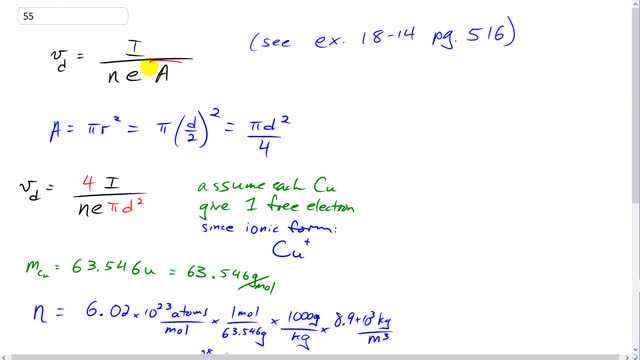
A 0.65-mm-diameter copper wire carries a tiny dc current of . Estimate the electron drift velocity

In order to watch this solution you need to have a subscription.
This is Giancoli Answers with Mr. Dychko. Drift velocity is the current divided by the volume density of electrons times the charge on an electron times the cross-sectional area of the wire. And this comes from equation 18-14… Oh, sorry example 18-14 on page 516. Now the cross-sectional area of the wire will be pi times its radius squared and radius is diameter over two and this makes pi d over four and we will substitute that in for A and dividing by A is the same as multiplying by its reciprocal. So we'll flip this fraction and it makes four over pi d squared so it just replaced A in this drift velocity formula. Now each copper ion has one free electron because the ionic form of copper is Cu one plus. And so that means each copper must, you know, have available one electron to put into the pool of free electrons that are available to carry charge through the wire. So, we're going to have to figure out the number of… of copper ions per volume so that's the density of copper, copper atoms per volume and then say that each atom is capable of of sending off one electron since the ionic form is one plus. And. And so so we're gonna take the number of atoms per cubic meter and then multiply by the number of charges available per atom so that's one e, 1.6 times ten to the minus 19 coulombs per atom and then and then carry on, times by the area and so on there. So. the molar mass of the copper is 63.546 grams per mole and you can find that in the periodic table of elements and then we'll find its… its density of atoms per cubic metre by taking 6.02 times ten to the 23 atoms per mole. That's Avogadro’s number and and I wrote it this way because I know I want atoms on the top and I want cubic metres in the bottom of this atoms per cubic metre for density. And and so we'll take this molar mass and read it as one more for every 63.546 grams so that the moles cancels and we are left with atoms per gram and, and then we have this density, kilogram per meter cubed, which is meters cube in the denominator. That's good. And until… we'll change this grams into per kilogram by multiplying by 1000 grams per kilogram. And then times by 8.9 times ten to the three kilograms per meter cubed. That's the density of copper, the mass density of copper. And then this gives us the atomic density you might call it the number of atoms per cubic meter, 8.43137 times ten to the 28 atoms per cubic meter. And we take that, density of atoms multiplied by the available charge per atom to get the volume density of, of free electrons. So we have four times 2.7 times ten to the minus six amps divided by this volume density of atoms times the elementary charge per atom times pi times 0.65 times ten to the minus three meters, diameter of the wire, squared. And this gives 6.0 times ten to the minus ten meters per second as the drift velocity which is really slow.